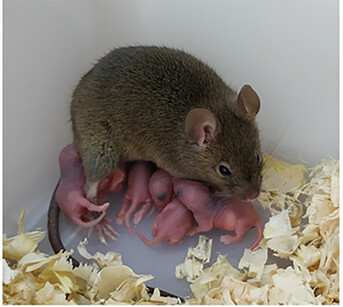
This female mouse, shown at an age of 4.5 months with her offspring, has no father. The mouse grew from a single unfertilised egg extracted from a female mouse (can one say “mother” in this age and circumstance?), then subjected to targeted DNA methylation rewriting by messenger RNA designed to modify seven imprinting control regions in the genome which are usually activated by the process of fusion with the DNA from sperm from a father. This allowed the unfertilised egg to develop into viable offspring, of which the mouse above is an example. That mouse was subsequently bred with a male mouse the old-fashioned way, resulting in the pups shown, which were found to exhibit no genetic abnormalities due to the genetic modification of the mother.
This work is described in a paper, “Viable offspring derived from single unfertilized mammalian oocytes”, published in the 2022-03-07 issue of PNAS. Full text is available at the link.
Significance
In mammals, parthenogenesis is limited because of problems arising from genomic imprinting. Here, we report live mammalian offspring derived from single unfertilized eggs. This was achieved by the targeted DNA methylation rewriting of seven imprinting control regions. By designing guide RNAs with protospacer adjacent motif (PAM) sequences matching one allele but not the other, dCas9-Dnmt3a or dCpf1-Tet1 enables targeted DNA methylation editing in an allele-specific manner. The success of parthenogenesis in mammals opens many opportunities in agriculture, research, and medicine.
Abstract
In mammals, a new life starts with the fusion of an oocyte and a sperm cell. Parthenogenesis, a way of generating offspring solely from female gametes, is limited because of problems arising from genomic imprinting. Here, we report live mammalian offspring derived from single unfertilized oocytes, which was achieved by targeted DNA methylation rewriting of seven imprinting control regions. Oocyte coinjection of catalytically inactive Cas9 (dCas9)-Dnmt3a or dCpf1-Tet1 messenger RNA (mRNA) with single-guide RNAs (sgRNAs) targeting specific regions induced de novo methylation or demethylation, respectively, of the targeted region. Following parthenogenetic activation, these edited regions showed maintenance of methylation as naturally established regions during early preimplantation development. The transfer of modified parthenogenetic embryos into foster mothers resulted in significantly extended development and finally in the generation of viable full-term offspring. These data demonstrate that parthenogenesis can be achieved by targeted epigenetic rewriting of multiple critical imprinting control regions.
In 2010, feminist Hanna Rosin published a book, based upon an earlier cover story in The Atlantic, titled The End of Men, in which she argued that women had “pulled decisively ahead [of men] by almost every measure”, thus decisively winning the “gender war”. In 2014, she wrote an opinion piece in Time titled, “Men Are Obsolete” (emphasis mine):
Are men literally obsolete? Of course not, and if we had to prove that we could never win. For one thing, we haven’t figured out a way to harvest sperm without them being, you know, alive. But in order to win this debate we have to prove that men, quote unquote, as we’ve historically come to define them — entitled to power, destined for leadership, arrogant, confused by anything that isn’t them. As in: “I don’t understand. Is it a guy dressed up like a girl? Or a girl dressed up like a guy?” They are obsolete.
Patience, Hanna…they’re working on it.